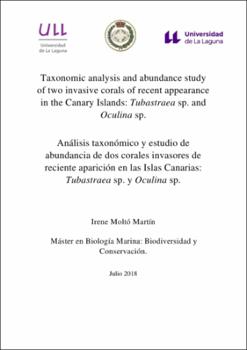Taxonomic analysis and abundance study of two invasive corals of recent appearance in the Canary Islands: "Tubastraea sp." and "Oculina sp"
Autor
Moltó Martín, IreneFecha
2018Resumen
En 2016 se registra por primera vez en las Islas Canarias dos escleractinias no nativas de los géneros Tubastraea y Oculina. Ambas especies han sido introducidas a través de los dos principales puertos canarios (el Puerto de Las Palmas de Gran Canaria y el Puerto de
Santa Cruz de Tenerife), a través de grandes plataformas petrolíferas. Los datos morfológicos permiten hacer una identificación como "T. coccinea" (Cairns, 2001; Cairns y Kitahara, 2012; Creed et al., 2017), la "Oculina" responde al tipo morfológico de "O. patagonica" descrita por Zibrowius (1976 y 1980) una especie nativa del Mediterráneo (Leydet y Hellberg, 2015; Terrón-sigler et al., 2016). En este estudio, analizaremos la
distribución y abundancia de "Tubastraea sp." y "Oculina sp.", en el puerto de Santa Cruz de Tenerife para ver el estado actual de la población y establecer una línea de base para futuros estudios. Analizaremos molecularmente ambas especies e intentaremos determinar su posible origen. Incluiremos también especies de "Tubastraea sp." recolectadas en Cabo Verde para aclarar la taxonomía de estos corales en la Macaronesia. In 2016 it is registered for the first time in the Canary Islands two non-native sclerantinians of the genus Tubastraea and Oculina. Both species have been introduced through the the two main Canary ports (Las Palmas de Gran Canaria harbor and Santa Cruz de Tenerife harbor), through the shipping of large offshore oil rigs. The morphological data allow to make an identification as "T. coccinea" (Cairns, 2001; Cairns & Kitahara, 2012; Creed et al., 2017), the "Oculina" responds to the morphological type of "O. patagonian" described by Zibrowius (1976 and 1980) a species native to the Mediterranean (Leydet y Hellberg; 2015; Terrón-sigler et al., 2016). In this study, we will analyze the distribution and abundance of "Tubastraea sp." and "Oculina sp.", in the sport port of Santa Cruz de Tenerife to see the current state of the population and stablish a base-line for future studies. We will also identify molecularly both species and we will try to determine its possible origin. We will also include species of "Tubastraea sp." collected in Cabo Verde in order to clarify the taxonomy of these corals in the Macaronesia.





